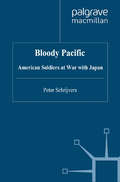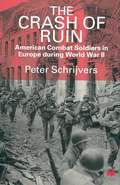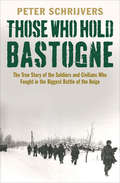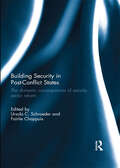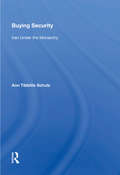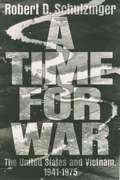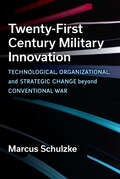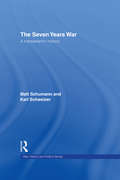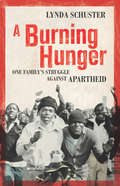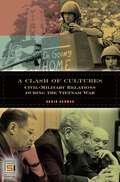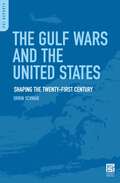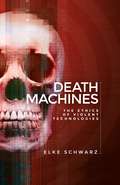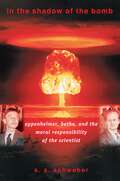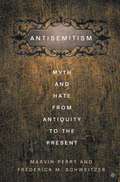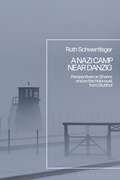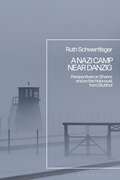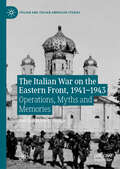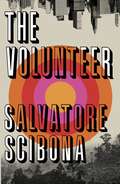- Table View
- List View
Bloody Pacific: American Soldiers at War with Japan
by P. SchrijversBased on countless diaries and letters, Schrijvers recounts American GIs' experiences in Asia and the Pacific. From the daunting spaces of the China-India theatre to the fortress islands of Iwo Jima and Okinawa, he brings to life their struggle with suffocating wilderness, devastating diseases, and Japanese soldiers who preferred death over life.
The GI War Against Japan: American Soldiers in Asia and the Pacific During World War II
by P. SchrijversBased on numerous diaries and letters, this book depicts the story of America's soldier sin Asia and the Pacific during World War II. Combining social and cultural history, the author examines the GIs' encounters with Asia's environmental, sociocultural and racial otherness and the impact that these encounters had on them. The Americans' experience in Asia and the Pacific presaged the devastation of Hiroshima and Nagasaki.
The Crash of Ruin: American Combat Soldiers in Europe during World War II
by Peter SchrijversThis book offers a compelling account of how America's combat soldiers experienced Europe during World War II. It paints a vivid picture of the GIs' struggles with its natural surroundings, their confrontations with its soldiers, their encounters with its civilians, and their reactions to uncovering the holocaust. The book shows how these harrowing experiences convinced the American soldiers that Europe's collapse was not just the result of the war, but also of the Old World's deep-seated political cynicism, economic stagnation, and cultural decadence.
Those Who Hold Bastogne: The True Story of the Soldiers and Civilians Who Fought in the Biggest Battle of the Bulge
by Peter SchrijversHitler’s last gamble, the Battle of the Bulge, was intended to push the Allied invaders of Normandy all the way back to the beaches. The plan nearly succeeded, and almost certainly would have, were it not for one small Belgian town and its tenacious American defenders who held back a tenfold larger German force while awaiting the arrival of General George Patton’s mighty Third Army. In this dramatic account of the 1944–45 winter of war in Bastogne, historian Peter Schrijvers offers the first full story of the German assault on the strategically located town. From the December stampede of American and Panzer divisions racing to reach Bastogne first, through the bloody eight-day siege from land and air, and through three more weeks of unrelenting fighting even after the siege was broken, events at Bastogne hastened the long-awaited end of WWII. Schrijvers draws on diaries, memoirs, and other fresh sources to illuminate the experiences not only of Bastogne’s 3,000 citizens and their American defenders, but also of German soldiers and commanders desperate for victory. The costs of war are here made real, uncovered in the stories of those who perished and those who emerged from battle to find the world forever changed.
Building Security in Post-Conflict States: The Domestic Consequences of Security Sector Reform
by Ursula SchroederSupport for security and justice institutions has become a crucial instrument of international engagement in fragile and conflict-affected states. In attempts to shore up security as a precondition for sustainable peace, international actors have become deeply engaged in reforming the security agencies and security governance institutions of states emerging from conflict. But despite their increasing importance in the field of international peace- and state-building, security sector reform (SSR) interventions remain both highly political and deeply contentious processes. Expanding on this theme, this edited volume identifies new directions in research on the domestic consequences of external support to security sector reform. Both empirically and theoretically, the focus lies on the so far neglected role of domestic actors, interests and political power constellations in recipient states. Based on a wide range of empirical cases, the volume discusses how the often conflictual and asymmetric encounters between external and domestic actors with divergent interests and perceptions affect the consequences of international interventions. By taking into account the plurality of state and non-state security actors and institutions beyond classical models of Weberian statehood, the contributions make the case for engaging more closely with the complexity of the domestic security governance configurations that can result from external engagement in the field of security sector reform.This book was published as a special issue of International Peacekeeping.
Buying Security: Iran Under The Monarchy
by Ann Tibbitts SchulzThis book looks at trends in military expenditures in Iran during, approximately, the three decades preceding the Islamic revolution of 1979 and their impact on economic growth and development. It focuses on military security policy, which establishes guidelines for military spending decisions.
Buying Security: Iran Under The Monarchy
by Ann Tibbitts SchulzThis book looks at trends in military expenditures in Iran during, approximately, the three decades preceding the Islamic revolution of 1979 and their impact on economic growth and development. It focuses on military security policy, which establishes guidelines for military spending decisions.
Die leisen Stimmen der Vernunft: Tonaufnahmen im Schlachthaus der Geschichte
by Peter Schulz-HageleitGeschichte als Abfolge von Massentötungen aller Art und – im Gegensatz dazu – Geschichte als Konzert von leisen Stimmen, die den Frieden beschwören und Vernunft anmahnen: das sind zwei Leitmotive des Buches, die in verschiedenen Inhaltsvariationen thematisiert werden. Dabei finden die grauenhaften Tatsachen der Geschichte ebenso Berücksichtigung wie die kognitiv-emotionale Schwierigkeit, im historisch-politischen Schlachthaus-Geschehen (Kriege, Völkermorde) nicht die Augen zu verschließen, sondern vielmehr standzuhalten und existenziell für eine bessere Welt einzutreten.Was zur Zeit der ersten Auflage des Buches (2006) weit entfernt von realgeschichtlichen Möglichkeiten zu liegen schien, ein imperialistischer Eroberungskrieg, ist seit Februar 2022 bedrückende Wirklichkeit. Die veränderte weltpolitische Konstellation entwertet die früheren Reflexionen und Recherchen nicht, sondern taucht die Befunde in ein noch grelleres Licht.Das Buch wendet sich nicht nur an Personen, die Geschichte professionell erarbeiten und vermitteln, sondern an alle, die im Verhältnis zur Geschichte, wie es medienwirksam präsentiert und zelebriert wird, Probleme sehen.
A Time for War: The United States and Vietnam, 1941-1975
by Robert D. SchulzingerEven after two decades, the memory of the Vietnam War seems to haunt our culture. From Forrest Gump to Miss Saigon, from Tim O'Brien's Pulitzer Prize-winning Going After Cacciato to Robert McNamara's controversial memoir In Retrospect, Americans are drawn again and again to ponder our long, tragic involvement in Southeast Asia. Now eminent historian Robert D. Schulzinger has combed the newly available documentary evidence, both in public and private archives, to produce an ambitious, masterful account of three decades of war in Vietnam--the first major full-length history of the conflict to be based on primary sources. In A Time for War, Schulzinger paints a vast yet intricate canvas of more than three decades of conflict in Vietnam, from the first rumblings of rebellion against the French colonialists to the American intervention and eventual withdrawal. His comprehensive narrative incorporates every aspect of the war--from the military (as seen in his brisk account of the French failure at Dienbienphu) to the economic (such as the wage increase sparked by the draft in the United States) to the political. Drawing on massive research, he offers a vivid and insightful portrait of the changes in Vietnamese politics and society, from the rise of Ho Chi Minh, to the division of the country, to the struggles between South Vietnamese president Diem and heavily armed religious sects, to the infighting and corruption that plagued Saigon. Schulzinger reveals precisely how outside powers--first the French, then the Americans--committed themselves to war in Indochina, even against their own better judgment. Roosevelt, for example, derided the French efforts to reassert their colonial control after World War II, yet Truman, Eisenhower, and their advisers gradually came to believe that Vietnam was central to American interests. The author's account of Johnson is particularly telling and tragic, describing how president would voice clear headed, even prescient warnings about the dangers of intervention--then change his mind, committing America's prestige and military might to supporting a corrupt, unpopular regime. Schulzinger offers sharp criticism of the American military effort, and offers a fascinating look inside the Nixon White House, showing how the Republican president dragged out the war long past the point when he realized that the United States could not win. Finally, Schulzinger paints a brilliant political and social portrait of the times, illuminating the impact of the war on the lives of ordinary Americans and Vietnamese. Schulzinger shows what it was like to participate in the war--as a common soldier, an American nurse, a navy flyer, a conscript in the Army of the Republic of Vietnam, a Vietcong fighter, or an antiwar protester. In a field crowded with fiction, memoirs, and popular tracts, A Time for War will stand as the landmark history of America's longest war. Based on extensive archival research, it will be the first place readers will turn in an effort to understand this tragic, divisive conflict.
Twenty-First Century Military Innovation: Technological, Organizational, and Strategic Change beyond Conventional War
by Marcus SchulzkeContemporary war is as much a quest for decisive technological, organizational, and doctrinal superiority before the fighting starts as it is an effort to destroy enemy militaries during battle. Armed forces that are not actively fighting are instead actively reengineering themselves for success in the next fight and imagining what that next fight may look like. Twenty-First Century Military Innovation outlines the most theoretically important themes in contemporary warfare, especially as these appear in distinctive innovations that signal changes in states’ warfighting capacities and their political goals. Marcus Schulzke examines eight case studies that illustrate the overall direction of military innovation and important underlying themes. He devotes three chapters to new weapons technologies (drones, cyberweapons, and nonlethal weapons), two chapters to changes in the composition of state military forces (private military contractors and special operations forces), and three chapters to strategic and tactical changes (targeted killing, population-centric counterinsurgency, and degradation). Each case study includes an accessible introduction to the topic area, an overview of the ongoing scholarly debates surrounding that topic, and the most important theoretical implications. An engaging overview of the themes that emerge with military innovation, this book will also attract readers interested in particular topic areas.
The Seven Years War: A Transatlantic History (War, History and Politics)
by Matt Schumann Karl W. SchweizerThe Seven Years War has been described as the first global conflict in history. It engulfed the Euro-Atlantic world from 1756 to 1763, and engaged the energies of European cabinets as never before. More than previous conflicts, the Seven Years War involved a variety of approaches to war, and taxed the military, material and moral resources of the powers involved. Drawing on a diverse array of archival, printed primary and secondary sources, The Seven Years War: A Transatlantic History covers the war’s origins, its conduct on land and at sea, its effects on logistics and finance, its interactions with domestic politics, its influence on international relations and its approach to peace. The book highlights the role of personality, alongside the enduring importance of communication, misperception and understanding. In so doing, it endeavours not merely to chronicle the war’s events, but to situate them in the context of mid-eighteenth century warfare, finance, politics and diplomacy. The Seven Years War will be of great interest to students of the European history, American history, maritime history, diplomatic and military history.
The Seven Years War: A Transatlantic History (War, History and Politics)
by Matt Schumann Karl W. SchweizerThe Seven Years War has been described as the first global conflict in history. It engulfed the Euro-Atlantic world from 1756 to 1763, and engaged the energies of European cabinets as never before. More than previous conflicts, the Seven Years War involved a variety of approaches to war, and taxed the military, material and moral resources of the powers involved. Drawing on a diverse array of archival, printed primary and secondary sources, The Seven Years War: A Transatlantic History covers the war’s origins, its conduct on land and at sea, its effects on logistics and finance, its interactions with domestic politics, its influence on international relations and its approach to peace. The book highlights the role of personality, alongside the enduring importance of communication, misperception and understanding. In so doing, it endeavours not merely to chronicle the war’s events, but to situate them in the context of mid-eighteenth century warfare, finance, politics and diplomacy. The Seven Years War will be of great interest to students of the European history, American history, maritime history, diplomatic and military history.
A Burning Hunger: One Family's Struggle Against Apartheid
by Lynda SchusterOn June 16 1976 the students of Soweto rose up in protest against a new rule that all teaching in African schools had to be done in Afrikaans. They were led by a charismatic young man called Tsietsi Mashinini. Tsietsi was one of the thirteen children of Joseph and Nomkhitha Mashinini, God-fearing, law-abiding citizens who had never been mixed up in politics. His actions on that day set in motion a chain of events that would forever define his family, and that would change all their lives. In A Burning Hunger Lynda Schuster tells the story of this remarkable family and in so doing tells the story of black South Africa in microcosm. For this is a family that embraces just about every facet of the liberation struggle. The eldest of the Mashinini children, Rocks, rose to a high rank in the army of the ANC; for years he directed the freedom fighters who infiltrated South Africa from neighboring countries in order to carry out sabotage. Tsietsi, brilliant, articulate, a natural leader, went underground after June 16 and then into exile. He was implacably opposed to the ANC and became the darling of Vanessa Redgrave, Stokely Carmichael and Miriam Makeba. He died in exile in 1990, just as his comrades were returning to their homeland. Mpho, the fourth son, was the most militant. He was eventually arrested, tortured and tried for treason. He went on to establish one of the most important anti-government organizations of the 1980s, the Soweto Youth Congress. Another brother, Dee, went to Tanzania in order to become a guerrilla, but was refused on the grounds of his youth. He eventually worked for Radio Freedom, the voice of the ANC. Yet another, Tshepiso, bookish, church-going, was torn between his studies and political activism. He eventually went to Oxford to study, and returned to South Africa in 1991, becoming a key figure on the Johannesburg council. If the Mandelas were the generals in the fight for black liberation, the Mashininis were the foot soldiers. It is the story of one black family, ordinary but also extraordinary. It is a story of imprisonment, torture, separation and loss, but also of dignity, courage and strength in the face of appalling adversity. It will become one of the seminal books about the struggle against apartheid.
A Clash of Cultures: Civil-Military Relations during the Vietnam War (In War and in Peace: U.S. Civil-Military Relations)
by Orrin SchwabThe Vietnam War was in many ways defined by a civil-military divide, an underlying clash between military and civilian leadership over the conflict's nature, purpose and results. This book explores the reasons for that clash—and the results of it.The relationships between the U.S. military, its supporters, and its opponents during the Vietnam War were both intense and complex. Schwab shows how the ability of the military to prosecute the war was complicated by these relationships, and by a variety of nonmilitary considerations that grew from them. Chief among these was the military's relationship to a civilian state that interpreted strategic value, risks, morality, political costs, and military and political results according to a different calculus. Second was a media that brought the war—and those protesting it—into living rooms across the land.As Schwab demonstrates, Vietnam brought together two leadership groups, each with very different operational and strategic perspectives on the Indochina region. Senior military officers favored conceptualizing the war as a conventional military conflict that required conventional means to victory. Political leaders and critics of the war understood it as an essentially political conflict, with associated political risks and costs. As the war progressed, Schwab argues, the divergence in perspectives, ideologies, and political interests created a large, and ultimately unbridgeable divide between military and civilian leaders. In the end, this clash of cultures defined the Vietnam War and its legacy for the armed forces and for American society as a whole.
The Gulf Wars and the United States: Shaping the Twenty-First Century (PSI Reports)
by Orrin SchwabSchwab's work is five-part analysis of US policy and strategy in the Persian Gulf from 1990-2003. He begins the work by analyzing the prominence of the Persian Gulf in US global strategic thinking during the last decade of the Cold War. By that time, gulf oil had secured a paramount place in the minds of the Reagan and Bush administrations. Part two dissects the relationship that individuals and regional governments in the Persian Gulf shared with the US. Here, Schwab also examines US perceptions of those entities and demonstrates how they helped shape the policies of the US and define the status of those nations in the eyes of US policymakers. When Saddam Hussein invaded Kuwait in 1990, the paradigm shifted dramatically. Part three examines US decision-making in the period immediately after that invasion. Schwab demonstrates that while forging a broad coalition to turn back Iraq was a significant diplomatic achievement, the international determination that defined the conflict in 1990-1991 eroded and gave way to a cumbersome policy of containment. That policy ultimately resulted in the dissolution of the coalition forged by the first Bush administration and burdened his successors as they struggled to achieve the longstanding goal of creating stability throughout the region. Part four explores the efforts of the Clinton and second Bush administrations in the Gulf. Saddam was one of the primary concerns of the Clinton administration, but so too were al-Qaeda, North Korea, China, and especially Yugoslavia. Indeed, his was the first administration to truly attempt to deal with these kinds of problems in a post-Cold War world. Despite their differences, there was a tremendous amount of continuity in the policies pursued by Clinton and George W. Bush. September 11 changed that, however, as Schwab chronicles in part five. In that section he explores how the current administration's adoption of a more proactive strategy of retaliation and preventative war has given rise to a new national security regime increasingly designed to fight asymmetric war while eliminating perceived threats to our national security and interests.Schwab's work is five-part analysis of US policy and strategy in the Persian Gulf from 1990-2003. He begins the work by analyzing the prominence of the Persian Gulf in US global strategic thinking during the last decade of the Cold War. By that time, gulf oil had secured a paramount place in the minds of the Reagan and Bush administrations. Part two dissects the relationship that individuals and regional governments in the Persian Gulf shared with the US. Here, Schwab also examines US perceptions of those entities and demonstrates how they helped shape US policy and define the status of those nations in the eyes of US policymakers. When Saddam Hussein invaded Kuwait in 1990, the paradigm shifted dramatically. Part three examines US decision-making in the period immediately after that invasion. Schwab demonstrates that while forging a broad coalition to turn back Iraq was a significant diplomatic achievement, the international determination that defined the conflict in 1990-1991 eroded and gave way to a cumbersome policy of containment. That policy ultimately resulted in the dissolution of the coalition forged by the first Bush administration and burdened his successors as they struggled to achieve the longstanding goal of creating stability throughout the region. Part four explores the efforts of the Clinton and second Bush administrations in the Gulf. Saddam was one of the primary concerns of the Clinton administration, but so too were al-Qaeda, North Korea, China, and especially Yugoslavia. Indeed, his was the first administration to truly attempt to deal with these kinds of problems in a post-Cold War world. Despite their differences, there was a tremendous amount of continuity in the policies pursued by Clinton and George W. Bush. September 11 changed that, however, as Schwab chronicles in part five. In that section he explores how the current administration's adoption of a m
Death machines: The ethics of violent technologies
by Elke SchwarzAs innovations in military technologies race toward ever-greater levels of automation and autonomy, debates over the ethics of violent technologies tread water. Death Machines reframes these debates, arguing that the way we conceive of the ethics of contemporary warfare is itself imbued with a set of bio-technological rationalities that work as limits. The task for critical thought must therefore be to unpack, engage, and challenge these limits. Drawing on the work of Hannah Arendt, the book offers a close reading of the technology-biopolitics-complex that informs and produces contemporary subjectivities, highlighting the perilous implications this has for how we think about the ethics of political violence, both now and in the future.
Death machines: The ethics of violent technologies
by Elke SchwarzDeath Machines offers a critical reconsideration of ethical theories and political justifications for technologised practices of violence in contemporary conflicts.
In the Shadow of the Bomb: Oppenheimer, Bethe, and the Moral Responsibility of the Scientist
by Silvan S. SchweberIn the Shadow of the Bomb narrates how two charismatic, exceptionally talented physicists--J. Robert Oppenheimer and Hans A. Bethe--came to terms with the nuclear weapons they helped to create. In 1945, the United States dropped the bomb, and physicists were forced to contemplate disquieting questions about their roles and responsibilities. When the Cold War followed, they were confronted with political demands for their loyalty and McCarthyism's threats to academic freedom. By examining how Oppenheimer and Bethe--two men with similar backgrounds but divergent aspirations and characters--struggled with these moral dilemmas, one of our foremost historians of physics tells the story of modern physics, the development of atomic weapons, and the Cold War. Oppenheimer and Bethe led parallel lives. Both received liberal educations that emphasized moral as well as intellectual growth. Both were outstanding theoreticians who worked on the atom bomb at Los Alamos. Both advised the government on nuclear issues, and both resisted the development of the hydrogen bomb. Both were, in their youth, sympathetic to liberal causes, and both were later called to defend the United States against Soviet communism and colleagues against anti-Communist crusaders. Finally, both prized scientific community as a salve to the apparent failure of Enlightenment values. Yet, their responses to the use of the atom bomb, the testing of the hydrogen bomb, and the treachery of domestic politics differed markedly. Bethe, who drew confidence from scientific achievement and integration into the physics community, preserved a deep integrity. By accepting a modest role, he continued to influence policy and contributed to the nuclear test ban treaty of 1963. In contrast, Oppenheimer first embodied a new scientific persona--the scientist who creates knowledge and technology affecting all humanity and boldly addresses their impact--and then could not carry its burden. His desire to retain insider status, combined with his isolation from creative work and collegial scientific community, led him to compromise principles and, ironically, to lose prestige and fall victim to other insiders. Schweber draws on his vast knowledge of science and its history--in addition to his unique access to the personalities involved--to tell a tale of two men that will enthrall readers interested in science, history, and the lives and minds of great thinkers.
In the Shadow of the Bomb: Oppenheimer, Bethe, and the Moral Responsibility of the Scientist
by Silvan S. SchweberIn the Shadow of the Bomb narrates how two charismatic, exceptionally talented physicists--J. Robert Oppenheimer and Hans A. Bethe--came to terms with the nuclear weapons they helped to create. In 1945, the United States dropped the bomb, and physicists were forced to contemplate disquieting questions about their roles and responsibilities. When the Cold War followed, they were confronted with political demands for their loyalty and McCarthyism's threats to academic freedom. By examining how Oppenheimer and Bethe--two men with similar backgrounds but divergent aspirations and characters--struggled with these moral dilemmas, one of our foremost historians of physics tells the story of modern physics, the development of atomic weapons, and the Cold War. Oppenheimer and Bethe led parallel lives. Both received liberal educations that emphasized moral as well as intellectual growth. Both were outstanding theoreticians who worked on the atom bomb at Los Alamos. Both advised the government on nuclear issues, and both resisted the development of the hydrogen bomb. Both were, in their youth, sympathetic to liberal causes, and both were later called to defend the United States against Soviet communism and colleagues against anti-Communist crusaders. Finally, both prized scientific community as a salve to the apparent failure of Enlightenment values. Yet, their responses to the use of the atom bomb, the testing of the hydrogen bomb, and the treachery of domestic politics differed markedly. Bethe, who drew confidence from scientific achievement and integration into the physics community, preserved a deep integrity. By accepting a modest role, he continued to influence policy and contributed to the nuclear test ban treaty of 1963. In contrast, Oppenheimer first embodied a new scientific persona--the scientist who creates knowledge and technology affecting all humanity and boldly addresses their impact--and then could not carry its burden. His desire to retain insider status, combined with his isolation from creative work and collegial scientific community, led him to compromise principles and, ironically, to lose prestige and fall victim to other insiders. Schweber draws on his vast knowledge of science and its history--in addition to his unique access to the personalities involved--to tell a tale of two men that will enthrall readers interested in science, history, and the lives and minds of great thinkers.
Anti-Semitism: Myth and Hate from Antiquity to the Present
by F. Schweitzer M. PerryIn this provocative book, Marvin Perry and Frederick M. Schweitzer analyze the lies, misperceptions, and myths about Jews and Judaism that anti-semites have propagated throughout the centuries. Beginning with antiquity, and continuing into the present day, the authors explore the irrational fabrications that have led to numerous acts of violence and hatred against Jews. The book examines ancient and medieval myths central to the history of anti-semitism: Jews as 'Christ-killers', instruments of Satan, and ritual murderers of Christian children. It also explores the scapegoating of Jews in the modern world as conspirators bent on world domination; extortionists who manufactured the Holocaust as a hoax designed to gain reparation payments from Germany; and the leaders of the slave trade that put Africa in chains. No other book has focused its attention exclusively on a thematic discussion of historic and contemporary anti-semitic myths, covering such an expansive scope of time, and allowing for such a painstaking level of exemplification. Anti-semitism is an essential book that will serve as a corrective to bigotry, stereotype, and historical distortion.
Amateurtheaterprojekte zu Holocaust und Nationalsozialismus: Eine qualitative Studie zur Erinnerungskultur im 21. Jahrhundert (Holocaust Education – Historisches Lernen – Menschenrechtsbildung)
by Lisa SchwendemannIn diesem Buch wird das Rezeptionsverhalten von Zuschauer(inne)n erforscht, welche Amateurtheaterprojekte zu ‚Holocaust und Nationalsozialismus‘ besuchen. Die Studie ist qualitativ angelegt, indem Interviews mit Hilfe der Grounded Theory ausgewertet werden. Es wird der Frage nachgegangen, welcher Personenkreis von Amateurtheaterprojekten angesprochen wird, wie diese Projekte von den Theaterbesucher(inne)n wahrgenommen werden und welche Wirkungen die Rezipient(inn)en während und nach dem Theaterbesuch an sich feststellen. Es kann herausgearbeitet werden, dass die in dieser Arbeit untersuchten Projekte eine intellektuelle Auseinandersetzung mit ‚schwieriger‘ Geschichte fokussieren. Die in den Amateurtheaterprojekten gewählte theatrale Darstellungsweise spricht tendenziell ein ‚bildungsnahes‘ Publikum an, das bereits über Vorwissen zur Thematik verfügt und bereit ist, sich während und nach dem Theaterbesuch aktiv mit ‚Holocaust und Nationalsozialismus‘ auseinanderzusetzen. Hierzu hat die Autorin ein Rezeptionsmodell herausgearbeitet, das die intellektuelle Auseinandersetzung mit ‚schwieriger‘ Geschichte umfasst.
A Nazi Camp Near Danzig: Perspectives on Shame and on the Holocaust from Stutthof
by Ruth SchwertfegerWithin the vast network of Nazi camps, Stutthof may be the least known beyond Poland. This book is the first scholarly publication in English to break the silence of Stutthof, where 120,000 people were interned and at least 65,000 perished. A Nazi Camp Near Danzig offers an overview of Stutthof's history. It also explores Danzig's significance in promoting the cult of German nationalism which led to Stutthof's establishment and which shaped its subsequent development in 1942 into a Concentration Camp, with the full resources of the Nazi Reich.The book shows how Danzig/Gdansk, generally identified as the city where the Second World War started, became under Albert Forster, Hitler's hand-picked Gauleiter, 'the vanguard of Germandom in the east' and with its disputed history, the poster city for the Third Reich. It reflects on the fact that Danzig was close enough to supply Stutthof with both prisoners – initially local Poles and Jews – as well as local men for its SS workforce. Throughout the study, Ruth Schwertfeger draws on the stories of Danziger and Nobel Prize winner, Günter Grass to consider the darker realities of German nationalism that even Grass's vibrant depictions and wit cannot mask. Schwertfeger demonstrates how German nationalism became more lethal for all prisoners, especially after the summer of 1944 when thousands of Jewish woman died in the Stutthof camp system or perished in the 'death marches' after January 1945. Schwertfeger uses archival and literary sources, as well as memoirs, to allow the voices of the victims to speak. Their testimonies are juxtaposed with the justifications of perpetrators. The book successfully argues that, in the end, Stutthof was no less lethal than other camps of the Third Reich, even if it was, and remains, less well-known.
A Nazi Camp Near Danzig: Perspectives on Shame and on the Holocaust from Stutthof
by Ruth SchwertfegerWithin the vast network of Nazi camps, Stutthof may be the least known beyond Poland. This book is the first scholarly publication in English to break the silence of Stutthof, where 120,000 people were interned and at least 65,000 perished. A Nazi Camp Near Danzig offers an overview of Stutthof's history. It also explores Danzig's significance in promoting the cult of German nationalism which led to Stutthof's establishment and which shaped its subsequent development in 1942 into a Concentration Camp, with the full resources of the Nazi Reich.The book shows how Danzig/Gdansk, generally identified as the city where the Second World War started, became under Albert Forster, Hitler's hand-picked Gauleiter, 'the vanguard of Germandom in the east' and with its disputed history, the poster city for the Third Reich. It reflects on the fact that Danzig was close enough to supply Stutthof with both prisoners – initially local Poles and Jews – as well as local men for its SS workforce. Throughout the study, Ruth Schwertfeger draws on the stories of Danziger and Nobel Prize winner, Günter Grass to consider the darker realities of German nationalism that even Grass's vibrant depictions and wit cannot mask. Schwertfeger demonstrates how German nationalism became more lethal for all prisoners, especially after the summer of 1944 when thousands of Jewish woman died in the Stutthof camp system or perished in the 'death marches' after January 1945. Schwertfeger uses archival and literary sources, as well as memoirs, to allow the voices of the victims to speak. Their testimonies are juxtaposed with the justifications of perpetrators. The book successfully argues that, in the end, Stutthof was no less lethal than other camps of the Third Reich, even if it was, and remains, less well-known.
The Italian War on the Eastern Front, 1941–1943: Operations, Myths and Memories (Italian and Italian American Studies)
by Bastian Matteo SciannaThe Italian Army’s participation in Hitler’s war against the Soviet Union has remained unrecognized and understudied. Bastian Matteo Scianna offers a wide-ranging, in-depth corrective. Mining Italian, German and Russian sources, he examines the history of the Italian campaign in the East between 1941 and 1943, as well as how the campaign was remembered and memorialized in the domestic and international arena during the Cold War. Linking operational military history with memory studies, this book revises our understanding of the Italian Army in the Second World War.
The Volunteer: A Novel
by Salvatore ScibonaAn odyssey of loss and salvation ranging across four generations of fathers and sons, in the finest tradition of American storytelling.The year is 1966 and a young man named Vollie Frade, almost on a whim, enlists in the United States Marine Corps to fight in Vietnam. Breaking definitively from his rural Iowan parents, Vollie puts in motion a chain of events that sees him go to work for people with intentions he cannot yet grasp. From the Cambodian jungle, to a flophouse in Queens, to a commune in New Mexico, Vollie's path traces a secret history of life on the margins of America, culminating with an inevitable and terrible reckoning.Scibona’s story of a restless soldier pressed into service for a clandestine branch of the US government unfolds against the backdrop of the seismic shifts in global politics of the second half of the twentieth century. Epic in scope but intimate in feeling, this is a deeply immersive read from a rising star of American fiction.
